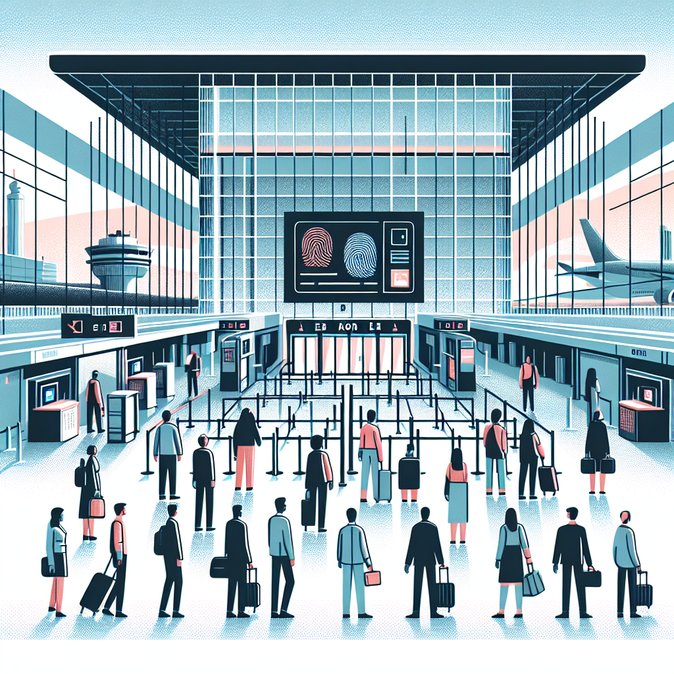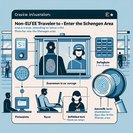
Zurich Airport has become the last of Switzerland’s three international hubs to switch on the European Union’s Entry/Exit System (EES). After a quiet soft-launch earlier in the week, the full roll-out was confirmed on 20 November 2025, when 52 Secunet self-service kiosks and e-gates went live in all non-Schengen arrival halls.
How EES changes the passenger journey: Third-country nationals visiting the Schengen area must now enrol four fingerprints and a live facial image the first time they cross an external EU/Schengen border. Subsequent trips require only a passport scan and facial match. The information is stored for three years in a central database that automatically counts each traveller’s days in/out, replacing passport stamps.
Operational impact: Border Police report that first-time enrolments add 30–60 minutes during peak arrival banks, prompting airlines to send pre-flight briefings and to stagger disembarkation. HR and travel managers are advised to budget at least 90 minutes for connections from long-haul to Schengen flights until passenger flows stabilise. Corporates rotating contractors on short assignments must now tighten day-count trackers; an over-stay will trigger an automatic alert at the next border crossing.
![Zurich Airport Activates EU Entry/Exit System, Adding Biometric Kiosks for All Non-EU Travellers]()
Strategic context: Switzerland is implementing EES ahead of the EU’s 10 April 2026 deadline and several months before ETIAS (the electronic travel authorisation for visa-exempt visitors) goes live. Basel and Geneva airports completed their switch-overs in October, giving Swiss authorities valuable data to refine staffing models and signage before the Zurich go-live.
Practical tips for mobility managers:
• Encourage assignees to use quieter mid-day arrival windows when possible.
• Provide newcomers with step-by-step kiosk guides in multiple languages.
• Align internal day-count software with the EES definition of “stay” (entry and exit days both count as full days).
• Review privacy notices: biometric data is retained for three years and may be accessed by all Schengen states for law-enforcement purposes.
Next milestones: Zurich Airport plans to open a dedicated EES help-desk in the Arrival 2 hall before the December holiday rush. The Federal Office for Customs and Border Security will publish its first queue-time statistics in February 2026.
How EES changes the passenger journey: Third-country nationals visiting the Schengen area must now enrol four fingerprints and a live facial image the first time they cross an external EU/Schengen border. Subsequent trips require only a passport scan and facial match. The information is stored for three years in a central database that automatically counts each traveller’s days in/out, replacing passport stamps.
Operational impact: Border Police report that first-time enrolments add 30–60 minutes during peak arrival banks, prompting airlines to send pre-flight briefings and to stagger disembarkation. HR and travel managers are advised to budget at least 90 minutes for connections from long-haul to Schengen flights until passenger flows stabilise. Corporates rotating contractors on short assignments must now tighten day-count trackers; an over-stay will trigger an automatic alert at the next border crossing.

Strategic context: Switzerland is implementing EES ahead of the EU’s 10 April 2026 deadline and several months before ETIAS (the electronic travel authorisation for visa-exempt visitors) goes live. Basel and Geneva airports completed their switch-overs in October, giving Swiss authorities valuable data to refine staffing models and signage before the Zurich go-live.
Practical tips for mobility managers:
• Encourage assignees to use quieter mid-day arrival windows when possible.
• Provide newcomers with step-by-step kiosk guides in multiple languages.
• Align internal day-count software with the EES definition of “stay” (entry and exit days both count as full days).
• Review privacy notices: biometric data is retained for three years and may be accessed by all Schengen states for law-enforcement purposes.
Next milestones: Zurich Airport plans to open a dedicated EES help-desk in the Arrival 2 hall before the December holiday rush. The Federal Office for Customs and Border Security will publish its first queue-time statistics in February 2026.









